Menu
Free Consultation
Jaw fracture, which occurs due to various causes such as a fall, a work accident or a traffic accident, is a problem that needs to be treated urgently and negatively affects a person's life. A jaw fracture with symptoms such as pain, swelling, difficulty chewing, and bleeding in the mouth can cause facial swelling when it occurs in the upper jaw.
A jaw fracture, which can be defined as a fracture of one or more of the bones that make up the jawbone, can also occur without any known cause. A stress fracture caused by grinding teeth for a long time or clenching the jaw is the most common type of spot jaw fracture.
It is possible to treat a jaw fracture with different techniques. Resting the jaw with a strap or wire is often a preferred method to ensure that the jaw area remains motionless during the healing process. After the jawbone treatment is applied, the pain can be reduced and the patient's comfort can be increased with the help of different painkillers.
In case of an infection in a jaw fracture, antibiotic therapy should be started. Surgical intervention may be required, especially if the bones are significantly displaced, an infection occurs, or if the expected recovery cannot be achieved after a few weeks of healing.
The most commonly used treatment for a jaw fracture is to splint the jaw and wait for the jaw to heal by prescribing painkillers. At this stage, if the fracture is displaced, an X-ray can be performed to determine whether there is a fracture in the jaw or whether there is a problem with jaw bone resorption. If there is severe pain on the face or the mouth cannot be opened properly, an orthodontist or oral surgery should be applied without delay.
Before starting treatment for a jaw fracture, the mouth and jaw are examined to determine whether there is a fracture. If there is a fracture in the jaw, it is necessary to decide whether surgery is necessary. At this stage, an X-ray is usually taken to determine whether the jaw fracture needs time to heal on its own. The purpose of jaw fracture treatment is to correct the jaw fracture and keep it in place until it heals. For this, a screw can be inserted into the bone or a screw plate can be used to stabilize the fracture site.

Jaw fracture treatment takes an average of 4 weeks. The healing process may vary depending on the size of the jaw fracture and the damage it causes for each patient. Depending on this, it can last up to 8 weeks.
The first treatment of the patient after the examination begins with anesthesia, so it is possible to prevent the patient from experiencing pain. In cases where the patient's teeth do not meet each other, the necessary treatment is performed. The patient is treated without any pain under the effect of anesthesia. Depending on the condition of the damage caused to the jaw, the bones are replaced first. In case of bone loss, it may be necessary to add metal parts or bone. The jaw is connected through the use of wire.
The symptoms that may be caused by a jaw fracture can be listed as follows:
The recovery time of a jaw fracture may vary depending on the patient's age, general health status, which bone region the fracture is located in, how many fragments the fracture is and similar elements. This period usually ranges from 4 to 8 weeks. Dec. The full recovery process is usually completed within 6 months.
In case of jaw fracture, oral care should be performed in a complete manner and due attention should be paid to oral hygiene. In addition to brushing your teeth regularly, it is also recommended to gargle. In order to prevent a possible infection, all the recommendations of the doctor must be fulfilled completely. In this way, it may be possible to experience a fast and healthy recovery process.
If abnormal swelling occurs in the area where the fracture is located after the first 7 days, it is necessary to consult a doctor. In case of possible bleeding, it is also important to go to the doctor without moving the fracture site. Patients should not move the jaw fracture area during the treatment process, and should also fully comply with all the recommendations of their doctors.
There are many different points that need to be considered in order for the treatment of jaw fracture to be successful and for the process to proceed correctly. In order to experience a fast and healthy recovery process, it is necessary to regularly use antibiotics and pain reliever-derived medications prescribed by the doctor. It is important for patients to follow a nutrition program in which liquid and soft foods are predominant throughout the healing process, and to take care not to chew.
One of the most important issues in the healing process is to ensure the best oral hygiene. It should be cleaned with a soft brush and mouthwash should be used, taking care not to damage the periphery of the applied wires. An ice compress should be made to reduce the swelling within the first 24 hours following the surgical operation. In this context, the ice bag is kept in the area for 10 minutes and pulled for 10 minutes. The swelling should start to go down within the first 4 to 7 days. It is necessary to consult a doctor, as the swelling may start to increase instead of going down, which may be a harbinger of infection.
Maintaining the incision site correctly and regularly is important both to ensure infection control and to prevent scarring. Due to the stitches in the mouth, the inside of the mouth should be lightly brushed and antiseptic mouthwash should be used. The bandage should not be removed until the stitches inside the mouth are removed. After the sutures are removed, the incision area should be cleaned with soapy water or peroxide and topical antibiotics should be applied. Staying away from the sun's rays and using sunscreen creams for the 6-month period following the surgery is extremely important to prevent scarring.
Due to the general anesthesia applied during the operation, it is recommended to avoid tasks that require attention for the first 24 hours. In addition, care should be taken not to use alcohol and cigarettes until the treatment is completed. The wires, which are one of the extremely important elements of the treatment, may loosen over time, and when they become excessively loose, there may be a need for intervention.
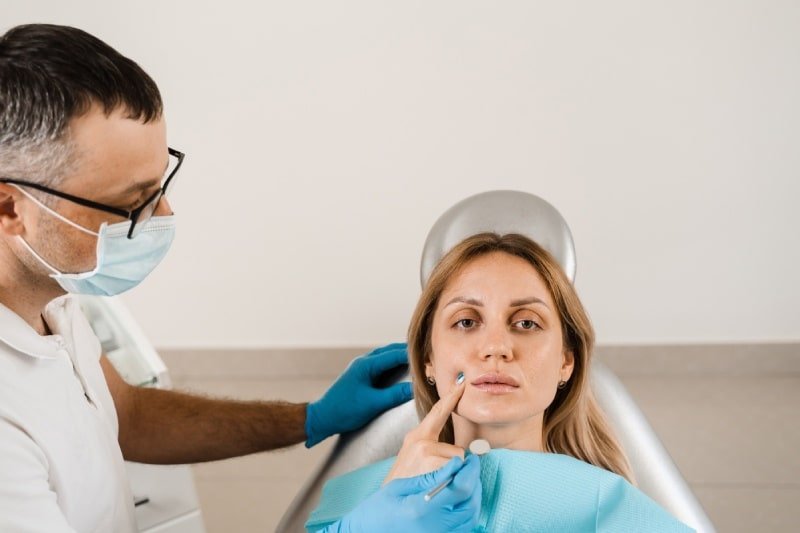
Fractures may occur in one or more places of the jawbone as a result of traumatic events such as falls, blows and accidents. Due to a jaw fracture, symptoms such as swelling, pain, bruising, difficulty chewing and speaking may occur.
Prices for jaw fracture treatment may vary depending on many different factors. The first of these factors is the location and type of fracture. It is possible for a jaw fracture to be single-sided or double-sided, simple or complicated. Complicated fractures can cause fragmentation or displacement of bone fragments, which can affect the course of treatment and, accordingly, their price. In addition, the severity of the fracture, the expertise and experience of the doctor performing the treatment, and the pricing policy of the clinic where the treatment is performed can also be listed among the elements that have an impact on the prices of jaw fracture treatment. Dec.
In order to determine the prices of jaw fracture treatment, oral and dental examination of the patient should be performed first. However, jaw fracture surgery prices can be determined after patient-specific treatment planning.
Disorders caused by the jaw joint may occur as a result of a sudden deterioration of the harmony of the surrounding tissues with the joint area connecting the upper jaw and lower jaw, or over time. Jaw joint disorders can progress as long as they are not treated. Depending on this, problems such as locking of the jaw, pain, restriction of mouth opening, head and neck pains may occur.
Diseases such as jaw shift, jaw dislocation and jaw joint disease are disorders that occur in the jaw joint. Diseases of the jaw joint are called TMJ, that is, Temporomandibular Joint Disorders. Basically, they are disorders that occur as a result of intra- or extra-articular pathology in joint functions.
Located just in front of the external auditory meatus, where the lower and upper jaw meet, TMJ is an extremely playful joint located between the temporal Decussation under the temporal bone and the temporal bone lump. Disorders that occur in the jaw joint affect the system consisting of teeth, lips, salivary glands, head and neck muscles and lig Novices.
In order to start the treatment of the jaw joint, it is first necessary to correctly diagnose the disease. In order to diagnose jaw joint disorders, the closing system of the mouth, teeth and jaw joint are examined in detail. In addition, the characteristics of the chewing muscles are evaluated. Nov. After these researches are carried out in detail, patient-specific treatment planning is made. If deemed necessary, MRI examination and intra-articular imaging methods are applied.
Jaw joint treatment is performed according to the diagnosis made after clinical and radiological examinations performed by the maxillofacial surgeon on a patient-specific basis. As a result of the diagnosis, movement restriction, diet, exercise, medication or surgical treatment procedures may be applied.
The primary goal of jaw joint treatment is to identify and eliminate the cause that leads to jaw joint discomfort. In cases where a single form of treatment is not sufficient, multidisciplinary studies may be applied. According to the diagnosis, medical or surgical treatments may be on the agenda.

Drug therapy is often preferred in the treatment process of jaw joint diseases. Painkillers and November muscle relaxants can optimize the patient's overall comfort. These medications prescribed by the doctor should be used regularly for a certain period of time. In this way, the patient's muscles relax, November's pain eases and the overall quality of life increases.
One of the most important methods in the treatment of jaw joint diseases is physical therapy. Electric currents, superficial and deep tissue heaters are used. In this way, it is possible to reduce November November muscle aches, relieve November December muscle spasms, stretch shortened tissues and muscles. Thanks to the relief of general pain and discomfort, the jaw joint can be restored to its normal function.
Cold therapy is usually one of the most effective methods for the treatment of jaw joint diseases after trauma or surgery. It may be possible to reduce swelling and pain in the jaw area with cold treatment. In this way, a rapid healing process can be encouraged.
In some cases, it may be necessary to inject into the joint in order to treat jaw joint diseases. In such cases, it may be the case of injecting painkillers directly into the joint, or injecting substances that will increase joint lubricity if joint irregularity has increased.
Another of the most preferred methods in the treatment of jaw joint is splint treatment. In patients where the disc is displaced, the disc is inserted into the mouth in order to bring the disc to a normal position. It is also possible to apply splint therapy to relax November muscles, correct closing disorders and minimize functional disorders in cases of grinding teeth.
Within the scope of the manipulation method, the jaw joint is manually moved to the normal position. In cases where the mouth opening is restricted, this method can be used to provide normal range of motion. Manipulation is one of the effective methods that can be preferred for the treatment of jaw joint diseases.
How long the jaw joint treatment will take may vary depending on the type, degree and preferred treatment method of the problem to be treated on a patient-specific basis. In general, it can be said that the treatment of the jaw joint can last between 3 months and 1 year. Dec. How long the jaw joint treatment will take can be determined by performing a patient-specific examination, diagnosing the problem, and planning treatment. In addition, it may vary depending on how long the patient follows the dentist's recommendations and how he responds to the applied treatment.
Jaw joint treatment can mainly be applied to people who complain of jaw joint disorders. In this way, the symptoms caused by jaw joint diseases can be alleviated and the patient's quality of life can be optimized. In order to get the optimal benefit from jaw joint treatment, dentists who are specialists and experienced in their field should be consulted.
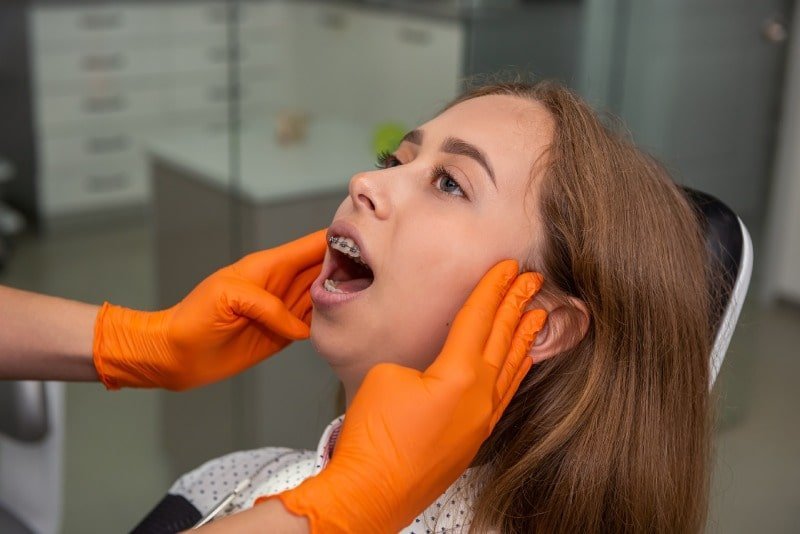
After the jaw joint treatment, there are some important points that should be taken into account to experience a faster recovery process and to prevent recurrent problems. At the beginning of these comes nutrition. After the jaw joint treatment, patients should include soft and easy-to-chew foods in the nutrition program. Care should be taken not to consume hard foods and large bites. For this, it is important to break food into small pieces, chew it slowly and thoroughly. In addition, care should be taken to stay away from acidic and spicy foods and drinks, consume plenty of water.
Teeth should be brushed at least twice a day with a soft-bristled toothbrush and a fluoride toothbrush, flossing regularly. Routine dental check-ups should also not be disrupted. The jaw exercises given by the dentist should be performed regularly. However, exercises should not be performed more than necessary and a break should be taken if pain is felt Decently.
In addition, for the protection of joint health, care should be taken not to chew gum, not to eat nails, to use plaque at night if there are problems with clenching or grinding teeth during sleep. Another important issue is to stay away from stress and learn stress management techniques.
It is important for patients to fully comply with the dentist's recommendations both during and after jaw treatment, in order to experience a fast and healthy recovery process. In addition, thanks to this, it is possible to prevent the recurrence of jaw joint disorders.
Jaw joint disorders are often seen in men and women of different age groups. Prices for jaw joint treatment, like all other dental procedures, may vary depending on certain factors.
Prices for jaw joint treatment may vary depending on the type of patient-specific treatment, the quality of equipment used during treatment, the experience of the dentist performing the treatment, and the pricing policy of the clinic where the treatment is performed.
It is very important for health that the upper and lower jaw offer a harmonious functionality. Orthognathic surgical procedures can be performed to treat disorders between the lower and upper jaw in order to have a Decently chewing, biting, breathing, swallowing and sleeping experience.
Surgical or non-surgical interventions performed to correct deformities in the jaw structure are included in the scope of jaw correction. Jaw correction procedures are generally performed to correct the anomalies in the patient's jaw, to balance the jaw line and to eliminate the dysfunctions in the jaw. In this way, it may be possible to correct problems related to the size, position or angles of the jaw. At the same time, a better appearance can be achieved aesthetically.
Surgery to advance and regress the lower and upper jaw bones with interventions to be performed on the lower and upper jaw bones in order to have a healthy mouth structure and biting function is called orthognathic surgery. Before and after the jaw correction surgery, the positions of the teeth are shaped separately with the support of the orthodontics department, and the treatment process is completed.
The patient is prepared by orthodontists. After the joint evaluation process, it is decided how many mm the jaws will be moved, whether only one upper jaw or one lower jaw will be intervened in the operation, or both jaws at once.
Radiographs and tomographs of the patient are taken before the jaw correction surgery. The operation is planned and the patient is photographed. The patient should quit smoking before surgery due to the risk of negatively affecting wound healing. In addition, heavy diet regimens should be avoided before surgery. Preoperative tests and anesthesia consultation are performed. In this way, the possible risks are evaluated before the operation. If necessary, it may be necessary to prepare blood for use in the operation.
The patient is taken to the surgery with a 6-hour hunger and the jaw correction surgery is performed under general anesthesia. Incisions are made through the mouth or through the skin. In this way, the lower jaw bone (mandible) and/or the upper jaw bone (maxilla) are reached. After cutting the bones from a suitable place, titanium plates or dissolvable plates are used to identify the bones.
After the bone detection procedure, stitches are made to the intraoral and skin incisions. A drain is placed to absorb the liquid that will accumulate in the area. It is possible that the materials used to fix the bones can remain for life or be removed at will after a few years.

The cases in which jaw correction surgery or jaw disorder surgery can be performed are listed below:
Jaw disorders are usually caused by genetics. People with a jaw structure disorder usually have the same disorder in their mother, father, or very close relatives. In addition, jaw and facial injuries and accidents October passed at a young age can also cause jaw disorders. Some diseases that prevent breathing through the nose in children may cause jaw structure disorders at the end of the growth process.
The teeth are located on the jaw bones, and it is not enough to have only smooth teeth, an aesthetic appearance and correct functions. In other words, both the jaw structure and the teeth should be in the correct position. Accordingly, correcting only the teeth of people with jaw disorders does not ensure achieving the desired result.
Jaw disorders can cause both tooth and jaw functions to be performed correctly and smile aesthetics to be inaccessible. People with jaw structure disorders, on the one hand, may not be able to fully perform basic functions such as chewing and speech, on the other hand, while experiencing aesthetic disorders. In addition, jaw joint disorders, easy tooth decay, chronic dental traumas and tooth loss may occur due to a jaw disorder.
Jaw correction treatment not only provides an aesthetic correction, but also does not provide functional benefits. Thanks to the movement of the jaws and teeth to the correct position, positive results can be achieved aesthetically and functionally.
Thanks to the jaw correction treatment, it is ensured that the facial features become more harmonious and balanced. As a result, a more aesthetically attractive and satisfying appearance can be accessed.
Jaw correction treatment, which allows the teeth and jaw to be straightened, helps to achieve a more natural and beautiful smile. As a result, a person's self-confidence and social life can be positively affected. Depending on the correction of the jaw, the patient's lips gain a fuller and more pronounced appearance.
Thanks to the correct position of the teeth, it is possible to chew food better. This also brings with it the advantage that the digestive system works more healthily. Correction of the jaw and teeth can also help to eliminate some speech disorders. Temporomandibular joint disorders are a disorder that occurs in the jaw joint, and it may be possible to alleviate or eliminate the symptoms of this disorder with jaw correction treatment. Jaw correction therapy can also help treat some cases of sleep apnea.
Jaw correction treatment brings with it many benefits if it is planned specifically for the patient by specialists and experienced dentists in the field and applied with the right techniques. Jaw correction surgery is a surgical procedure performed to bring the jaws and teeth into the correct position.
Jaw correction surgery, like any surgical procedure, brings with it the risk of anesthesia. After surgery, there is usually a slight bleeding that passes on its own at a slight level and within a short period of time. In order to minimize the risk of developing a possible infection, antibiotics should be used and proper wound care should be applied. There is a risk of facial scarring after surgery. However, it is out of the question that these scars become pale and lose their distinctiveness over time.
There is a risk of nerve damage during jaw correction treatment. This may lead to permanent drowsiness in some cases, temporary in some cases. Although it is possible to feel sensitivity in the teeth after surgery, this condition usually resolves on its own within a few weeks. There may be gum irritation after surgery. If the necessary attention is not paid to oral hygiene, gum diseases may occur due to irritation.
In some cases, a melt in the jawbone may occur after jaw correction treatment. There may also be problems with opening the mouth. Such problems, which are temporary, can usually be resolved with physical therapy.
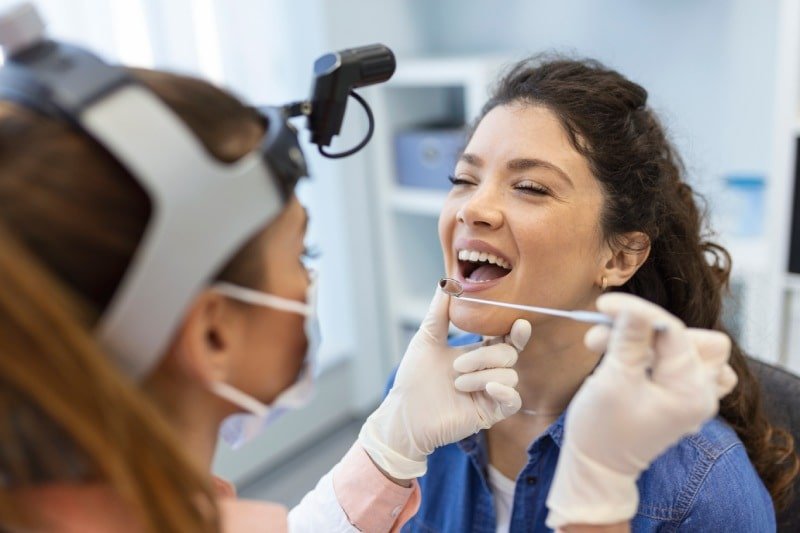
The patient's dental position, speech, breathing and chewing functions are evaluated. If there are buried 20-year-old teeth, they are removed at least 6 months before the operation. Orthodontic wire treatment is applied to prepare the position of the teeth for surgery.
Soft and easily chewable foods should be consumed at an early stage after the operation, and ice compresses should be applied to reduce swelling and pain. During this process, you should avoid heavy exercises and activities, lie on your back for the first few weeks. In addition, attention should be paid to oral hygiene.
Jaw correction treatment prices may vary for each patient depending on the treatment to be applied, the scope of treatment, the dentist's experience and the clinic's pricing policy.
The small metal pieces that are attached to the teeth during braces treatment are called "brackets". Braces treatment is applied to correct the shape and position of the teeth, and brackets are applied to align the teeth correctly.
During braces treatment to correct the teeth, brackets are glued onto the teeth. Wires are then used to connect the brackets to each other and these wires are stretched. After the brackets are attached to the patient's teeth, the braces are checked at regular intervals and the wires are tightened. In this way, the position of the teeth is changed. The duration of braces treatment can vary from a few months to several years, depending on the current condition of the patient's teeth.
One of the most important parts of braces treatment is the brackets. This is because the brackets play a critical role in the process of straightening the teeth. Although braces treatment can be a long process that requires regular check-ups, it is considered an excellent way to have correctly aligned and healthy teeth.
However, it is possible to experience various problems during bracket use. The main one is pain. Pain may occur in the mouth during or after the braces are inserted. Although this pain, which is usually mild, subsides within a few days, painkillers can increase the comfort of the patient during this period.
Gum sensitivity may develop after the braces are fitted. In this case, it is necessary to clean the gums regularly and use the dental floss and toothbrush recommended by the dentist.
It is possible to see discoloration of the teeth during the use of braces. Such situations can be remedied by cleaning the teeth after the brackets are removed. Some patients may experience speech problems after the braces are burned. This situation improves within a few days after getting used to the brackets. If the brackets cause swallowing problems, dentists may need to correct the brackets. For the success and comfort of bracket treatment, the dentist's recommendations should be followed exactly.

There are different types of brackets and the type of bracket to be used depends on various patient-specific factors.
Metal brackets, which are frequently used in dentistry, are mostly made of stainless steel. In this way, they adhere better to the teeth. In braces treatment, small tires are used to hold the wire passing through the metal brackets in place. Arc wires in metal braces have a thin structure. Today, smaller metal brackets are used in braces treatment. Metal brackets are considered to be advantageous solutions because they have less friction with the archwires.
Because they are made of ceramic material, ceramic braces have a more natural tooth color. Thanks to the aesthetic advantage it brings with it, it is often preferred in braces treatments. However, since ceramic brackets have large sizes, food accumulation may occur on the teeth. Accordingly, patients with ceramic braces should pay due attention to oral and dental care. The structure of ceramic brackets is more fragile than metal brackets. In addition, it is possible to prolong the treatment time due to more friction with archwires.
Lingual braces, which are more costly than other types of braces, are designed specifically for the patient. Since the braces are placed on the back of the teeth and the brackets are located on the back of the teeth, the braces are not visible when laughing or talking. This eliminates aesthetic concerns. The lingual bracket, which is less affected by the procedures performed on the surface of the teeth because it is behind the teeth, also prevents scars on the teeth.
Damon braces, also called "self-ligating", are similar to metal braces. It is a type of bracket with low friction. In this way, it can help to achieve fast results in a short time.
Clear aligner treatment, also known as brace-free treatment, can replace braces or brackets. In this method, which uses patient-specific transparent aligners instead of brackets, a slight pressure is applied to move the teeth to the desired position.
Compared to traditional metal brackets, clear aligner treatment brings many advantages. It is also aesthetically advantageous as it is less prominent. Clear aligners that fit snugly to the teeth are easy to use. Since they are removable, oral and dental hygiene is easily ensured.
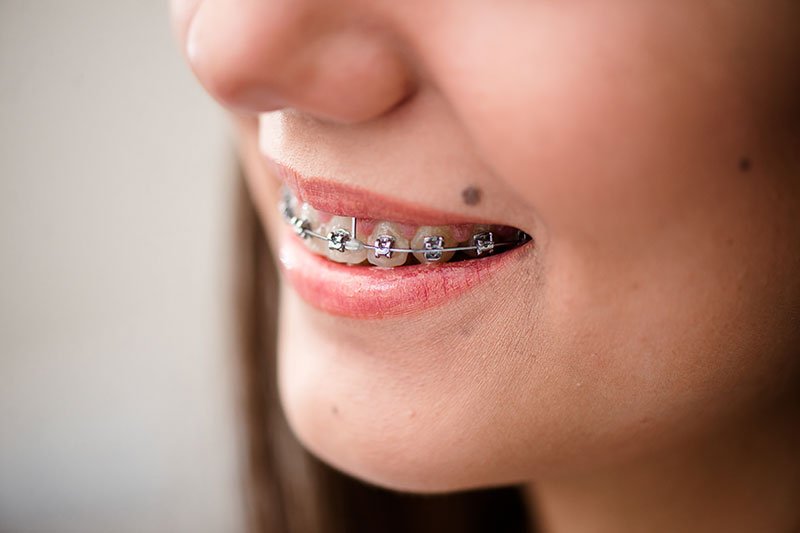
Although braces are thought to be a treatment method that works only in childhood, braces can also be applied in adulthood and extremely successful results can be obtained. For braces to be applied in children, deciduous teeth must have fallen out and all permanent teeth must have erupted. Bracket treatment cannot be applied to children whose deciduous teeth have not fallen out.
However, it is not correct and possible to use a racket to solve every dental problem. In this context, dentists identify and evaluate the problem specific to each patient and determine the most appropriate treatment method.
One of the most important factors for the protection of dental health and the success of the treatment is to apply bracket care correctly. For this, teeth should be brushed and flossed regularly. The area around the brackets and wires should be brushed carefully, especially around the brackets, as food accumulation around the brackets and wires can cause tooth decay.
Hard and sticky foods should be avoided to prevent food accumulation around the brackets. In addition, the dentist should be visited regularly for the maintenance of the brackets. During this visit, the dentist will check the brackets and make the necessary adjustments.
Since brackets are made of extremely durable materials, it is not common for them to break. Rarely seen bracket fracture is usually due to the consumption of hard foods. There is a risk of breaking the brackets when hard foods with shells are bitten with the teeth.
Another factor that causes the brackets to break is the weakening of the adhesives used during the application over time and the adhesives that come out of their place and cause rapid fracture. In such cases, even if the bracket does not break, if the adhesive material weakens and the brackets dislodge, the bracket must be re-glued. Otherwise, the success of the treatment may be negatively affected.
Dental brackets in Turkey provide an excellent opportunity for those seeking high-quality orthodontic care at a significantly lower cost. Patients worldwide are often pleasantly surprised by how affordable it is to achieve a beautifully aligned smile, with prices being a fraction of what they would pay in Western countries.
Turkey’s dental clinics combine affordability with cutting-edge technology and the expertise of highly skilled professionals, ensuring that treatment quality is never compromised. Patients can expect to save between 50-70% compared to prices in Europe or North America, making Turkey a leading destination for orthodontic care.
Clinics offer a wide range of orthodontic options tailored to fit each patient’s needs and preferences. Whether you’re opting for traditional metal braces, clear ceramic brackets, or invisible aligners, Turkish dental clinics provide solutions for every lifestyle and budget.
Moreover, Turkish clinics are renowned not only for their medical expertise but also for their warm hospitality. This combination of professional care and cultural warmth ensures that your journey toward a perfectly aligned smile is effective and enjoyable.
Choosing Turkey for dental care can improve your smile while experiencing a vibrant new culture!
MosDent Dental Hospital is a top choice for patients seeking dental brackets in Turkey. Known for its blend of advanced technology and highly skilled orthodontic specialists, MosDent provides exceptional care in a comfortable and welcoming environment.
One of the critical strengths of MosDent is its focus on personalized treatment plans. Each patient’s orthodontic needs and goals are unique, and the team at MosDent takes the time to thoroughly assess your situation and design a treatment plan that best suits your needs.
“Patient comfort” is another priority at MosDent. From your initial consultation to your final check-up, every aspect of the process is carefully managed to ensure a stress-free and pleasant experience.
Affordability is a significant draw for patients at MosDent, where transparent pricing and flexible payment options make it possible to achieve your dream smile without financial strain. This affordability makes MosDent the ideal choice for orthodontic treatment combined with world-class care.
With a focus on excellence and a commitment to patient satisfaction, MosDent Dental Hospital is ready to guide you through your orthodontic journey with professionalism and care.
In the orthodontic treatment process, the attachments glued on the teeth to move the teeth are called "brackets". There are many different types of brackets. However, even though the type of brackets changes, their role in the braces treatment process and the purpose of the treatment do not change. Which bracket will be used during braces treatment is determined by the dentist on a patient-specific basis, depending on the shape of the defect in the teeth and the problem to be eliminated.
During bracket selection, the patient's age, aesthetic expectations, cost and the dentist's recommendations are evaluated. Then the right choice is made to ensure the success and comfort of the treatment.
Bracket prices vary depending on the current condition of the patient's teeth, the type of bracket preferred, the duration of the treatment and other factors. Since the treatment process is planned individually for the patient, bracket prices can be determined after the patient is examined.
Bonding is one of the most commonly used dental procedures to restore tooth integrity. Bonding treatment is applied to restore dental aesthetics. In addition to changing the color, shape and size of the teeth, bonding can also be used to eliminate various dental defects that detract from the aesthetic appearance.
Bonding treatment is also known as aesthetic filling or composite laminate. An important advantage of the procedure is that there is no need to remove tissue from the tooth surface during the application. It is applied by adding bonding material or composite resin compatible with the natural color of the tooth to the area to be treated. The application is usually completed in one session. In this way, the person can achieve an aesthetic tooth appearance quickly, practically and painlessly.
The aesthetic dentistry procedure applied by applying a tooth-colored composite material to the tooth, shaping, hardening and polishing it is called bonding. It is an ideal method that is often preferred in small-scale aesthetic dentistry applications to fix broken or chipped teeth for any reason or to eliminate small gaps between teeth.
Thanks to bonding, the overall appearance of the teeth can be improved comfortably and quickly. The main purpose of bonding treatment is to optimize dental aesthetics by repairing, reshaping, lightening or straightening the teeth. The procedure is planned and performed individually for the patient. By using an artificial resin material that has the ability to imitate a real tooth color, shape and volume are added to the tooth. Thus, an aesthetic tooth appearance can be achieved in a short time and at affordable costs.
In order to apply bonding, the tooth to be treated is first prepared. If there is no decay in the tooth, bonding can be performed without anesthesia. The composite filling color that will best match the natural color of the tooth to be treated is selected. For this, a color guide is used and then the treatment is started.
The surface of the tooth to be treated is roughened, then a conditioning fluid is applied to the surface. This step is applied to ensure that the user is better bonded to the tooth. The tooth-colored adhesive material is applied to the tooth and shaped. This should be done before the material hardens. After shaping, the bonding material is hardened with a laser or bright light. The dentist can shape or cut if necessary. The final step is a polishing to match the shade and brightness of the tooth surface, thus supporting the natural appearance.
Bonding is usually completed within 30 to 60 minutes. This time may vary depending on the current condition of the tooth, how many teeth will be treated, the expertise of the dentist, the quality of the material used and similar factors.
It is usually possible to complete the bondign application in a single session. However, depending on the scope of the procedure, more than one session may be required for each patient.

Bonding is an effective method that can be applied not only to treat tooth fractures, but also to give perfect-looking teeth and a successful smile design. Bonding is more affordable than other aesthetic dentistry procedures. In addition, a tooth that has undergone bonding treatment can be re-bonded if needed.
Bonding is an application in the form of natural teeth, so it is not noticeable from the outside. It is a dental procedure that increases the resistance of teeth against staining. Anesthesia is usually not required for bonding application.
The application is done with the least possible tooth loss. Thanks to bonding treatment, which helps to increase the patient's comfort and self-confidence, tooth wear can be removed quickly.
It is possible to get permanent and durable results if bonding is applied by specialized and experienced dentists with quality materials and correct techniques. Of course, for long-term and healthy use, attention should be paid to important points such as following the dentist's recommendations after bonding treatment and not neglecting oral and dental care. If the necessary care is taken in all these matters and routine dental examinations are not neglected, bonding treatment provides permanent results for 7 to 10 years.
Bonding;
In order to maintain oral and dental health, individuals should be attentive not only after bonding treatment but also at all times, and should fulfill their oral and dental care routine regularly. However, the fact that dental care becomes more important after any dental procedure, especially bonding, should not be ignored.
Especially in the first 2 days after the bonding application, the consumption of foods and beverages that may cause discoloration and staining of the teeth should be avoided. Making mistakes in nutrition can cause staining and yellowing of the teeth and reduce the benefit of bonding treatment. In particular, consuming tea, coffee, cigarettes and other tobacco products can have negative effects on tooth color. Although it is possible to prevent possible deformations with polishing, the number of additional sessions can be reduced with the right care, saving both time and cost.
The things to be considered after bonding application can be listed as follows:

Bonding prices may vary depending on the patient. When determining bonding prices, different factors such as how many teeth the treatment will be applied to, whether different dentistry procedures are required and the quality of the material to be used are evaluated. In addition, the expertise and experience of the dentist who will apply the bonding treatment and the price policy of the clinic where the application will be performed are also factors that affect bonding prices.
The prices of the bonding method, which is a dentistry procedure based on the application of designs planned according to tooth fractures or gaps, are more affordable than other aesthetic dentistry procedures.
The last adult teeth to erupt are called wisdom teeth or wisdom teeth. Wisdom teeth are molars located at the back of the jaw. When wisdom teeth do not adapt to the jaw structure, they can cause pain, abscess formation and discomfort. In such cases, the need for wisdom tooth extraction or dental surgery arises. The main factor causing this problem is that there is not enough space in the jaw for wisdom teeth to erupt.
A wisdom tooth can cause not only severe pain, but also disruption of the jaw structure and negative effects on the health of other neighboring teeth. For this reason, it is recommended that the dentist check the wisdom teeth when they start to erupt. In people with a suitable jaw structure, wisdom teeth may not need to be extracted, but in some cases, wisdom teeth may erupt at an incorrect angle and remain embedded in the gum because the jaw structure of the person is not suitable. In such cases, the wisdom tooth may not be visible from the outside. These teeth, defined as impacted wisdom teeth, are often recognized by the pain they cause.
It is possible to prevent wisdom teeth from negatively affecting the jaw and tooth structure and preventing unwanted problems such as abscesses by undergoing regular dental examinations. In case of regular dental examinations, it is possible to follow the process of the wisdom teeth starting to erupt and develop. In case of any negativity, the teeth can be extracted without damaging oral and dental health.
Wisdom tooth extraction is a dental procedure that is planned and performed depending on how far the tooth is from the gum. For wisdom tooth extraction, local anesthesia is first applied to the area. After the tooth is loosened, it is extracted with pliers. After cleaning the area where the tooth was extracted, bleeding is stopped. In some cases, a small incision must be made in the gum and the tooth must be cut into small pieces before it is removed.
Since there is not enough space in the jaw, wisdom teeth can erupt at an angle, get stuck, partially erupt or remain impacted. When the wisdom tooth is completely impacted, i.e. under the gum, it must be removed surgically. In this context, the patient may be sedated to numb the pain. The gum is cut and the wisdom tooth can be removed.
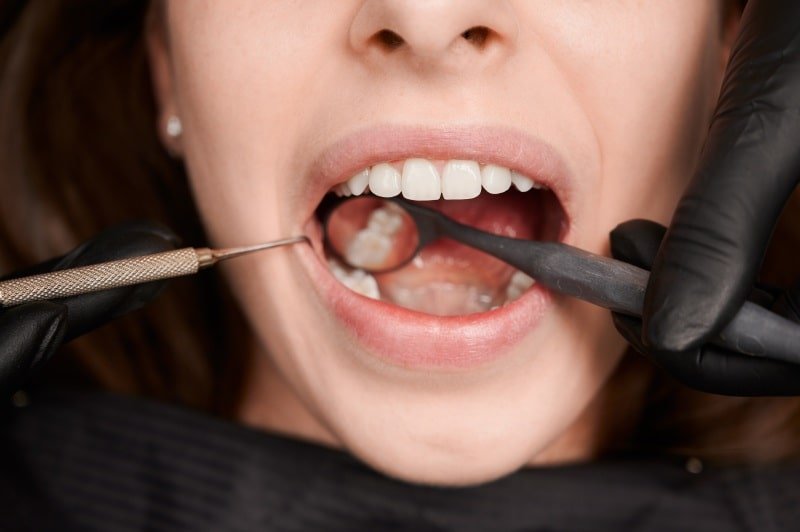
Wisdom teeth usually appear between the ages of 17 and 25. Although it is not mandatory to extract wisdom teeth that erupt as third molars as a result of eruption in the mouth, they may need to be extracted in some cases. The situations that require the extraction of wisdom teeth can be listed as follows:
There are 4 wisdom teeth in total. The wisdom teeth are located at the back of the upper and lower jaw. Wisdom teeth, which usually erupt around the age of 20, may not erupt in a healthy way for most people. They may be impacted or semi-implanted, they may compress the gums in the mouth because they cannot find enough space in the jaw, they may damage other teeth and cause pain.
In people whose jaw structure is appropriate and wisdom teeth find enough space to erupt, the eruption of these teeth does not cause any problems. On the other hand, wisdom teeth that are too far back and hard to reach may not be cleaned even if the necessary sensitivity is shown in oral and dental care. Depending on such reasons, wisdom teeth should be extracted in some cases or surgically removed if they are impacted.
The wisdom tooth erupts in the right and left most backward regions of the lower and upper jaw. There may be cases where wisdom teeth do not need to be extracted. In some people, wisdom teeth erupt without causing any pain and play a role in chewing. In such cases, wisdom teeth do not need to be extracted.
However, wisdom tooth extraction may be necessary if there is a product or gum infection, if the wisdom tooth presses on the tooth in front, or if it causes an infection in the affected area.

Pain and swelling may be observed for a few days after wisdom tooth extraction, and bruising may also occur. Bleeding is also possible during this period. The pain usually subsides within a week after the operation.
Teeth should be brushed gently for the first 24 hours, and care should be taken not to brush the extraction site and neighboring areas directly. In addition, the mouth should not be rinsed or gargled for the period specified by the dentist.
In the first days following wisdom tooth extraction, care should be taken to consume soft and juicy foods. Soups, purees and fruit juices can be included in the nutrition program during this period when hard and hard-to-chew foods should be avoided. In addition, the food and drinks consumed should be warm. It is recommended to stop smoking and drinking alcohol due to the risk of slowing down the healing process. Otherwise, unwanted complications may develop.
Antibiotics and painkillers prescribed by the dentist should be used regularly. Cold compresses may be useful to relieve pain and swelling in the application area. Care should be taken to keep the head slightly higher than the torso when lying down to prevent increased facial swelling.
Proper oral hygiene should be maintained to prevent the development of a possible infection. Drink plenty of water to remove food and bacteria from the teeth and gums.
Wisdom tooth extraction prices may vary depending on how the extraction procedure is performed. The prices of wisdom tooth extraction may be different if the tooth is easily removed directly in one piece, if it is embedded, if it is removed in pieces or if a surgical procedure is required. In addition, the type of anesthesia applied, the expertise of the dentist and the price policy of the clinic where the tooth extraction is performed are factors that are evaluated when determining the prices of wisdom tooth extraction.
One of the most important elements of a healthy and attractive smile is having beautiful and healthy teeth. However, over time, cavities, excessive discoloration and tooth form defects that appear on the front teeth can interfere with the beauty of this smile. In the past, porcelain veneers were the only way to fix such aesthetic problems. However, since porcelain veneers were applied by cutting away healthy tooth tissue, there was a risk of new problems.
Nowadays, thanks to advanced laminate techniques, porcelain sheets with little or no material loss are used, thus providing the opportunity to have eye-catching teeth and smiles.
In laminated dental applications, a thinning technique is used by preserving the intact tooth tissue and a veneer is applied. This technique stands out as one of the least invasive methods. In prepless laminate treatment, only chemical roughening and bonding techniques are used without any mechanical intervention on the tooth surfaces. This method protects the patient's natural teeth and offers a perfect aesthetic.
Specially prepared porcelain sheets are applied without any damage to the tooth. In this way, an aesthetic appearance is achieved with minimal intervention to the tooth tissue. This method offers an ideal solution for those who desire to have a whiter smile, those who cannot achieve the targeted benefit from teeth whitening procedures, those who have tooth fractures or abrasion problems, those with aesthetic concerns or those who suffer from problems after root canal treatment. However, conditions such as nail biting habits or jaw disorders may pose an obstacle to the application of laminated teeth. In such cases, these problems should be treated first and then laminated teeth should be applied.
Laminate is a highly aesthetic method especially preferred by people who are not satisfied with the shape or color of their teeth. In the traditional laminated dental veneer procedure, the front surface of the tooth is abraded between 0.3 and 0.7 mm. However, in the prepless laminate procedure, also known as the no-abrasion laminate method, no abrasion is performed on the teeth. This method offers a more minimally invasive approach and is considered an ideal option to meet aesthetic expectations.
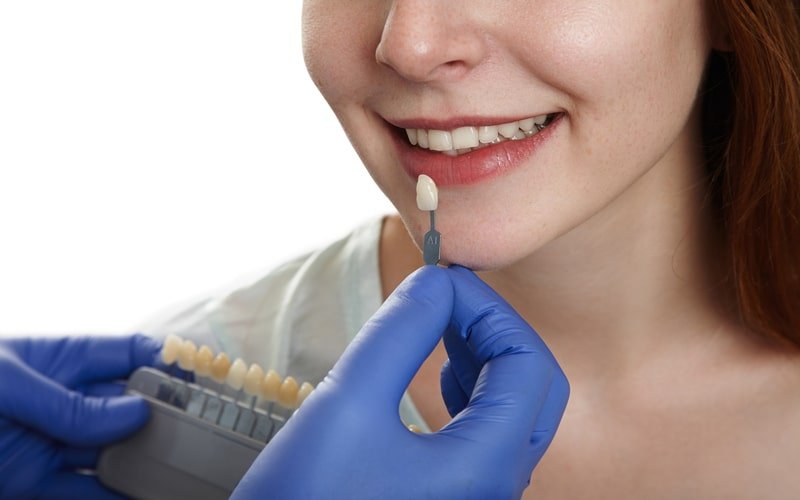
Prepless laminate treatment begins with a detailed examination of the patient's oral condition. During this examination, the patient's special needs and expectations are taken into account. Thus, the treatment process is planned specifically for the patient. Then, it is determined which teeth the laminate treatment will be applied to and oral impressions are taken.
Measurements are made on the models obtained and the photographs taken, and proofing material is used to obtain pre-approval from the patient. The most distinctive feature of the Prepless laminate method is that it is a procedure that does not require abrasion of the teeth. Therefore, there is no damage to the teeth and the laminate prepared in a computerized environment using ceramic blocks are strongly bonded to the teeth with a chemical bond.
Since Prepless Laminate treatment is a minimally invasive procedure, there is no risk to dental health and the results obtained are satisfactory. The natural structure of the teeth can be preserved as no procedure is performed on the teeth of the patients within the scope of Prepless Laminate treatment. It is a dental procedure that can be completed much easier and faster than traditional laminate treatment. Since the natural color and shape of the teeth are taken into consideration in prepless laminate treatment, an aesthetically satisfying and natural appearance can be achieved.
Since prepless laminate treatment is produced using highly durable materials, it can be used safely and comfortably for many years. Since no abrasion is applied to the teeth within the scope of prepless laminate treatment, minimal sensitivity may occur in the teeth. As a result of prepless laminate treatment, which is a very wide range of dental procedures, teeth can have a whiter and brighter appearance. For all these reasons, the prepless laminate method is considered a safe and effective option preferred by more and more patients every day.
Prepless laminate, which is frequently applied to solve problems such as gaps, fractures or discoloration in the teeth in a fast and aesthetic way, is a highly effective method. This treatment is usually completed within an average of one week and is applied without causing any loss of material in the teeth. This means that there is no need for abrasion. Prepless Laminate treatment, which is applied individually to each tooth, uses a material that has similar durability to natural tooth enamel. This material is not only highly resistant to breakage or abrasion, but also has the advantage of not changing color over time.
Since no intervention is made on the inner surfaces of the teeth during the prepless laminate treatment, there is no problem such as decreased comfort of the patients, and there is no feeling of foreignness on the tongue. In addition, thanks to the high light transmittance of the material, a natural tooth appearance is achieved. This method is considered to be an ideal solution for patients who want their teeth to have a more aesthetic appearance but do not want abrasion.
Another advantage of prepless laminate treatment is that it is a method that can be removed when desired and allows the preservation of natural teeth. Because, no abrasion is applied to the teeth during prepless laminate treatment. This feature gives patients the freedom to use their own teeth after treatment.

The decision on whether the patient is suitable for prepless laminate treatment is made by the dentist on a patient-specific basis by making the necessary evaluations. If the patient is deemed suitable for prepless laminate treatment, measurements are taken and the measurements taken are transferred to the laboratory environment. The design process is realized in a computer-aided environment. Prepless veneers are prepared in an average of 7 to 10 days. Their suitability on the teeth is evaluated and corrections are made if necessary.
After the dentist completes the evaluation process and the patient's approval is obtained, it is bonded to the teeth using special bonding techniques. Prepless laminate treatment is completed in an average of 7 to 10 days. This period may vary depending on the evaluation of the dentist, the patient's wishes, the need for different dentistry procedures and many other factors.
Prepless laminate treatment requires the patient to have completed tooth and jaw development. If the patient's development process is still incomplete, this process should be waited for and then the prepless laminate treatment should be started. Prepless Laminate treatment is not recommended for people with teeth clenching or grinding problems. Because, even though the laminated dental veneer is made of a durable porcelain material, it can be damaged when excessive force is applied. Therefore, it may be preferable to apply different aesthetic dental coating methods for people with such habits.
Thanks to advances in technology, prepless laminate has become an increasingly common dental procedure. This method is extremely popular with patients because it offers a natural look and does not require any abrasion to the teeth. However, it is important that the patient's tooth structure is suitable for this treatment. People with spaced tooth structure can usually achieve successful results with the prepless laminate method.
Prepless laminate treatment does not require any abrasion on the teeth, so patients are unlikely to feel sensitivity after treatment. However, it is extremely important to brush and floss regularly after treatment. In this process, it is recommended to prefer toothpastes that do not have an abrasive effect and contain fluorine. In addition, visits to the dentist should be continued every six months to maintain oral and dental health and to maintain the results of the prepless laminate treatment for a long time.
After Prepless Laminate treatment, patients do not feel any discomfort during eating. Also, problems such as discoloration or staining are not encountered. On the other hand, it is important to avoid the consumption of hard-shelled foods that can cause damage to the prepless laminate teeth.
Prepless laminate treatment offers an aesthetic and functional solution for people who find the natural form of their teeth small or have gaps between their teeth. In addition, prepless laminate treatment can also be preferred to correct excessive discoloration that cannot be removed by teeth whitening procedures or if the teeth are shaped differently than normal. This treatment can also be an effective solution if the enamel is extremely rough or if there are cavities on the enamel surface. As part of the smile design, it is possible to give an aesthetic touch to a person's smile by applying prepless laminate treatment.
Prepless laminate prices may vary depending on a number of factors. These factors include the price policy of the clinic where the treatment will be applied, the experience and expertise of the dentist, the number of teeth to be treated, whether a different treatment is required and the quality of the materials used. Therefore, pricing should be made after the treatment process planned specifically for each patient. In this way, a fair pricing can be ensured, taking into account the patient's specific needs and treatment plan.
Maxillofacial surgery, in other words oral and maxillofacial surgery, is the field that deals with the diagnosis and treatment of diseases affecting the mouth, jaw, face and neck. Diseases, disorders and injuries in the hard and soft tissues of the mouth, teeth and jaw area that occur in all age groups and methods for their diagnosis and correction are within the scope of oral and maxillofacial surgery.
Treatment of complex dental problems and medical conditions related to the mouth, teeth, jaw and face is performed within the scope of oral and maxillofacial surgery. Oral and maxillofacial surgery focuses mainly on facial reconstructive surgery, facial trauma surgery and dental procedures involving the jawbone, such as wisdom tooth extractions and dental implants.
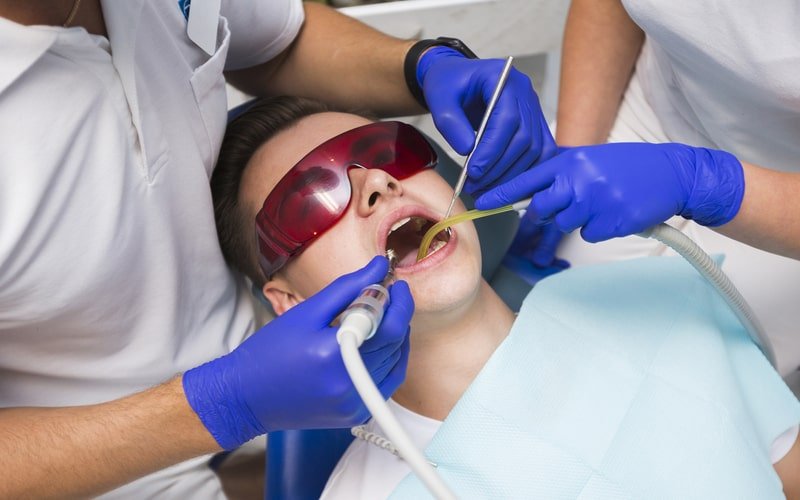
There are many different types of maxillofacial treatments. The most common types of maxillofacial treatment are listed below:
It is applied to correct one or more missing teeth. Implants, which are artificial tooth roots, support the restoration of the missing tooth while helping to stop or prevent jawbone loss.
The suitability of implant treatment is determined by a detailed examination and evaluation process. Teeth and gums are thoroughly examined. The assessment of bone density and quantity is very important for the success of implant treatment. X-rays and CT scans can be used to ensure that there is sufficient bone structure for the implants to be placed and to determine exactly where the implants should be placed.
The process of completely removing one or more teeth from the mouth is called tooth extraction. Although permanent teeth are intended to survive for life, tooth extraction may become necessary for some reasons. Tooth extractions can be simple or surgical. How the tooth extraction will be performed is determined by the shape, size, current condition and position of the tooth in the mouth. Extraction of teeth that appear above the gums and that the dentist can remove in one piece is called simple extraction.
Surgical extraction is a more complicated process. Surgical extraction involves the removal of gum tissue, bone or both, and the tooth may need to be removed in pieces. Since wisdom teeth are impacted in many people, they are the last teeth to erupt and usually the first teeth to be extracted.
In cases where tooth extraction is necessary, the patient is first consulted. Depending on the amount of bone, tooth or both to be removed, the patient may be asked to stop taking certain medications for a while before the procedure. Before the extraction, a dental x-ray is taken to evaluate the curvature and angle of the tooth root. After anesthesia is administered, the procedure begins.
In cases where the tooth is hidden under the gum tissue or bone, it may be necessary to cut the gum or remove the obstructing bone area. Stitches or additional procedures may be needed to control bleeding after extraction. The dentist or surgeon places a thick layer of gauze over the extraction site. The patient is asked to bite on it to absorb the blood and start the clotting process.
Sacs filled with air, liquid or semi-liquid/solid matter are called cysts; abnormal tissue masses are called tumors. One of the most important areas of oral and maxillofacial surgery is known as odontogenic cysts and tumors. Clinical and radiological examination and biopsy are used to diagnose cysts and tumors in the oral region.
Odontogenous cysts can be seen due to reasons such as progressive tooth and gum infections, impacted teeth, incompletely extracted and remaining roots, traumas, some developmental anomalies, incomplete and incorrectly applied treatments and genetic factors.
Enucleation and marsupialization methods are used in the treatment of cysts in the oral region. Enucleation is the complete removal of the cyst in a single session. In such cases, the infected root, tooth or impacted tooth that is thought to be the cause of the cyst is also removed simultaneously. In cases where the location and size of the cyst does not allow it to be removed in a single session, a marsupialization procedure is used. This procedure reduces the pressure inside the cyst and shrinks it. Once the cyst cavity is reduced, the cyst is completely removed with the enucleation procedure.
It is usually possible to treat benign tumors arising from the tooth and surrounding tissues under clinical conditions. For the treatment of malignant tumors, patients are referred to the relevant specialties.
Maxillofacial treatments;
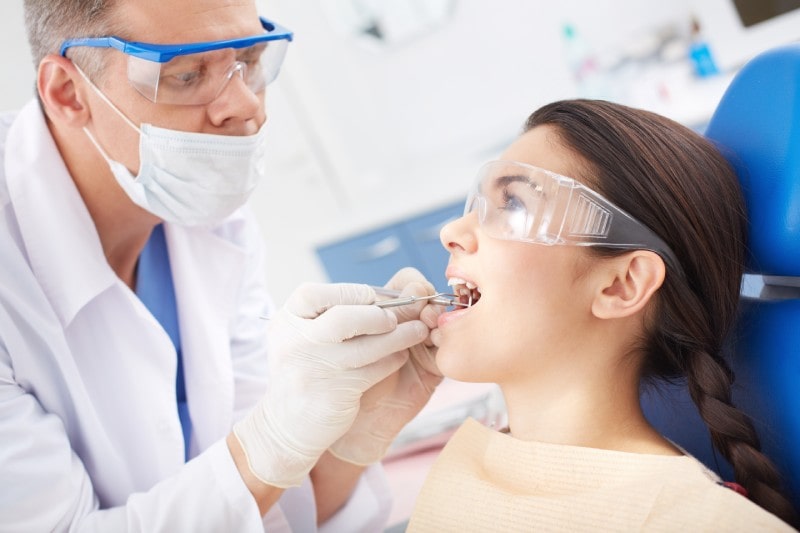
Maxillofacial treatment includes surgical procedures to treat many different conditions related to the teeth, jaw, mouth and face. There are different options for aesthetic corrections within the scope of oral and maxillofacial surgery. With dental implant and maxillofacial surgery procedures, new teeth can be made to replace tooth loss due to various reasons. At the same time, a more aesthetic smile can be achieved by correcting the jaw structure.
Maxillofacial treatments can treat severe tooth decay, fractures or other dental problems. The treatment can help to reduce pain, optimize chewing function and improve overall oral health.
Some people may have jaw anomalies, either congenital or due to accidents. It is possible to correct such problems with oral and maxillofacial surgery procedures. Dental implant treatment helps to eliminate tooth deficiencies that negatively affect daily life and can cause aesthetic concerns. Thus, it is possible to provide the patient with a similar appearance and function to natural teeth.
In addition to those listed above, it is possible to improve the general health status and quality of life of patients by applying maxillofacial treatment, that is, oral and maxillofacial surgery treatments in many different situations.
Maxillofacial treatment prices may vary depending on factors such as the scope of the treatment to be applied, the complexity of the procedure, the experience of the doctor who will perform the application and the price policy of the clinic where the application will be performed.
One of the most important factors for the success of dental implant treatment is the presence of sufficient bone support in the area to be treated. If there is no bone support with sufficient width and length in the area, implant treatment cannot be successful. For this reason, the first and most important step in patients with bone deficiency and implant treatment is to eliminate the bone deficiency problem.
Bone grafting is often preferred in patients who will undergo dental implant treatment. In case of bone loss in the jawbone, a series of procedures are applied to create bone in the lost area. The bone grafting procedure can be performed using bone tissue taken from the patient's own body, grafts obtained from animal sources or synthetic grafts.
Bone grafting, which is a surgical procedure, should be performed by an experienced and specialized dentist. In cases where the patient's bone tissue is used, graft material is usually taken from under the jaw. A solid structure is created on the jawbone to ensure suitability for implant treatment.
Bone grafting is an effective treatment used to create a suitable jawbone for implant treatment. Thanks to the bone grafting procedure, jawbone deficiency problems of patients who will receive dental implants are eliminated and a healthy and durable foundation is prepared for dental implants.
Bone graft treatment is used to compensate for the loss of jawbone due to various reasons and to create a suitable basis for dental implant treatment. Some conditions that require bone grafting can be listed as follows:
Some of the advantages of bone grafting treatment are as follows:
The types of dental bone graft are determined depending on the needs and general health status of the patient. Dental bone graft types are as listed below:
Autogenous grafts: Highly compatible autogenic grafts are made by taking tissue from the patient's own body.
Isogen grafts: Isolated grafts, in which tissue compatibility is extremely important, are applied by taking similar tissues from another living being.
Allogenic grafts: Allogeneic grafts, which are usually obtained from banks, include donor tissues with different genetic structures from the same species.
Xegonic grafts: They are usually of animal origin and are tissues taken from different species.
The types of dental bone graft listed above are used to eliminate the loss of jaw bone and to provide suitability for implant treatment.
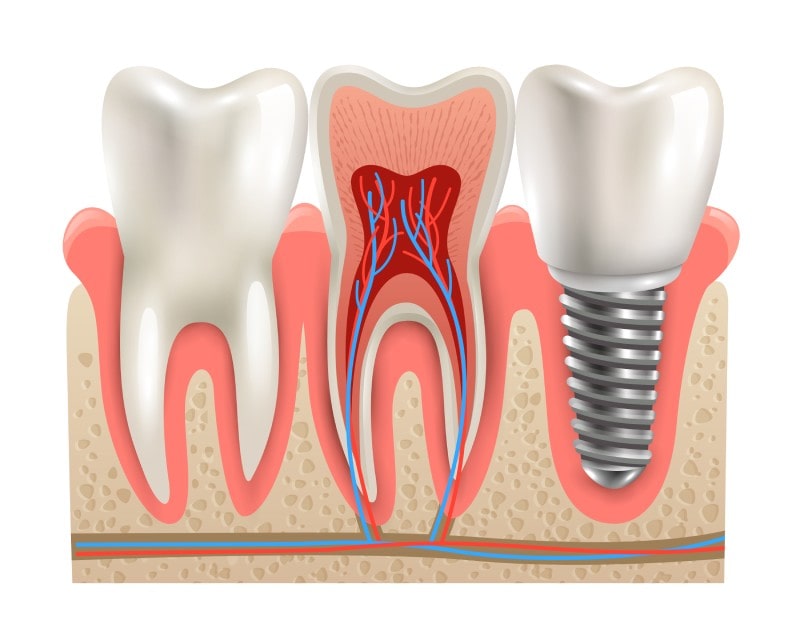
Dental bone grafting usually causes minimal pain and discomfort. On the other hand, the pain felt during dental bone grafting treatment may vary depending on the pain threshold, sensitivity to the surgical intervention and the application site.
Dental bone grafting is a procedure usually performed under local anesthesia. The application site is numbed with local anesthesia, which prevents pain during the operation. Patients may experience mild to moderate discomfort after the procedure. Post-procedure discomfort may vary depending on the complexity of the operation, the type of dental bone graft used and the general health of the patient.
Painkillers and anti-inflammatory medications prescribed by dentists can be used to reduce pain and discomfort after the procedure. In this way, the comfort of the healing process can be optimized.
The recovery time after dental bone graft treatment may vary depending on the patient-specific structural features and the type of dental bone graft used. Pain and discomfort usually decrease within a few days, and the healing process progresses smoothly.
The healing process of a dental bone graft can vary depending on the patient's general health condition, the graft material used, how well the patient follows the dentist's recommendations after the procedure and various other factors. Mild pain, swelling and bleeding may occur in the first 1 to 2 weeks after the procedure. The patient's comfort can be optimized during this period with the regular use of medications prescribed by the dentist.
Within a few weeks to a few months after the dental bone graft procedure, the process of integration of the graft material into the jawbone begins. A period of several months is needed to ensure long-term healing. Once this process is complete, a dental implant can be applied.
During the healing process after bone graft treatment, the treatment area should be kept clean and necessary oral care should not be neglected. Failure to pay due attention to oral hygiene after the procedure may lead to infection and various dental problems. During the first few days following the bone graft treatment, soft foods should be consumed and very hot drinks should be avoided.
It is recommended to sleep with the head elevated for the first 3 days to prevent blood accumulation at the incision site. The desired bone density in the bone grafted area is usually reached within 3 months after the procedure. During this period, it should not be disrupted to go to the controls requested by the dentist.
Bone grafts are used to replace or regenerate missing bone tissue on the jawbone or gums. Bone grafts work in various ways to stimulate bone regeneration.
Having beautiful and healthy teeth is one of the most important factors that make a person self-confident. It is often encountered that the opposite situation causes a lack of self-confidence. Aesthetic concerns about the appearance of teeth due to various reasons are eliminated by porcelain dental veneers. It is ensured that the individual has a more beautiful and healthy motive.
Another feature of porcelain dental veneers is that they not only give people the smile they want, but also ideal oral functions. Porcelain dental veneers are a patient-specific, in other words, customizable dental procedure. In this way, treatment is planned and porcelain dental veneers are prepared in accordance with the needs and expectations of each patient, as well as to provide a natural appearance. Effective results can be achieved by applying porcelain dental veneers in quality, shape and appearance to represent the natural appearance.
The dental coating technique, in which materials obtained from porcelain are used to cover the surface of natural teeth, is called porcelain dental veneers. Thanks to porcelain dental veneers, which is a cosmetic and restorative treatment method, it is possible to correct many different defects in the teeth. Porcelain dental veneers can be preferred to change the color, shape and size of damaged, crooked or gapped teeth. Porcelain veneers are produced in a laboratory environment following the process steps such as taking patient-specific measurements and mold removal.
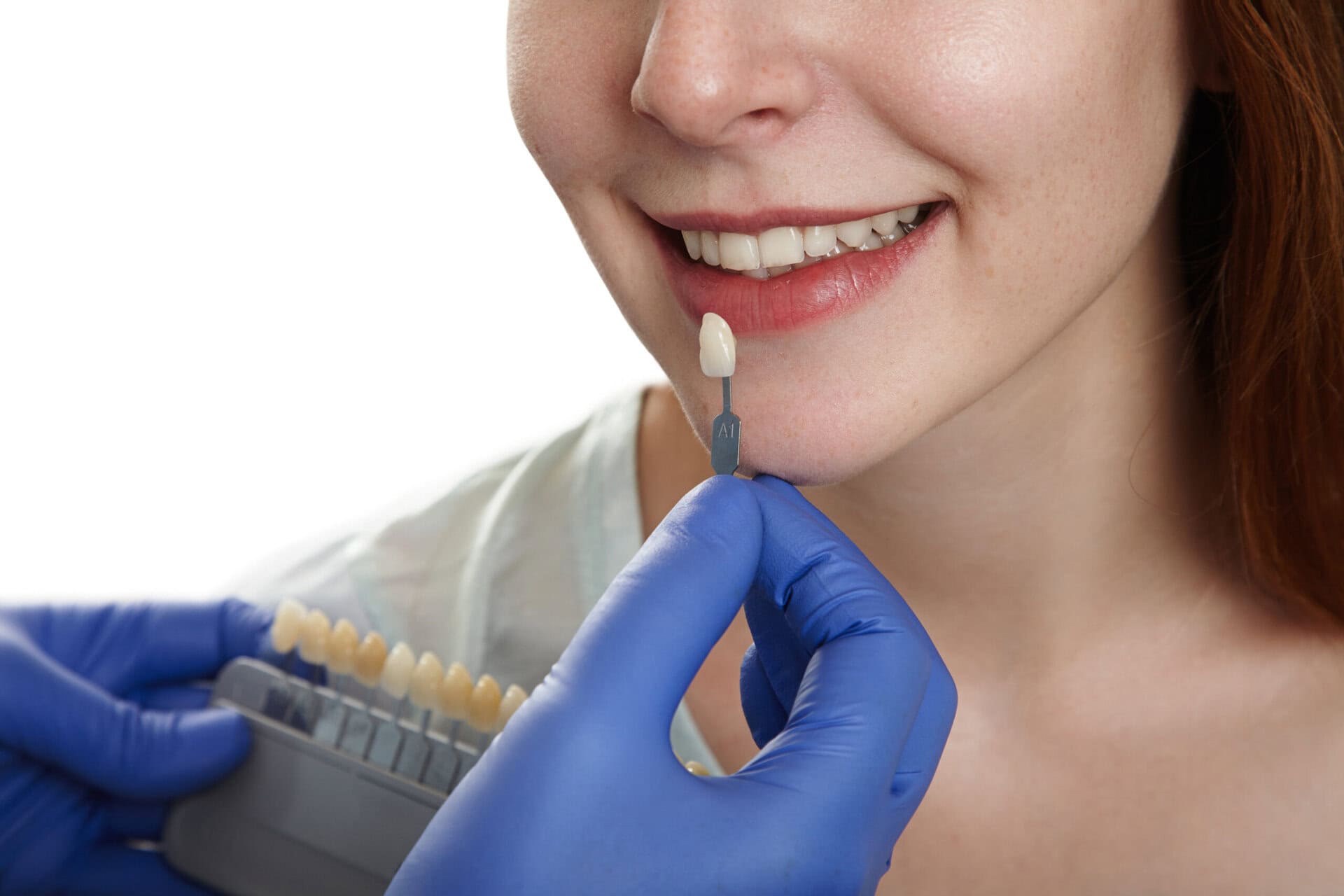
The patient who wants to have porcelain dental veneer treatment is informed about the process. He/she undergoes a detailed examination and X-rays are taken if deemed necessary. Measurements of the patient's existing teeth are taken and a model is created. With the help of computer technologies, a three-dimensional image of the teeth is obtained. The veneer is prepared in the dental laboratory using the models or images. Porcelain dental veneers are usually ready within 2 to 3 weeks. This period may vary depending on the number of teeth to be crowned.
To determine the most accurate color for porcelain dental veneers, the patient's teeth are thoroughly cleaned. The enamel layer of the tooth is slightly abraded and a new impression is taken. The abrasion process ensures that porcelain dental veneers adhere easily to the teeth. Temporary veneers are applied to the patients until porcelain dental veneers are prepared according to the measurements taken.
When porcelain dental veneers are ready, they are not immediately permanently bonded to the patient's teeth. First, porcelain dental veneers are temporarily bonded to the teeth. The patient is asked to use the teeth for a few days. The purpose of this is to evaluate the fit of the porcelain dental veneers.
At the end of the specified period, if the patient and dentist agree on the color and form of the porcelain dental veneers, the porcelain dental veneers are permanently bonded. A special adhesive is used for this and the porcelain dental veneers are fixed. They are then hardened by radiation curing, any excess is removed and the teeth are polished. A few weeks after the porcelain dental veneers treatment, the patient is called for a follow-up examination. The reaction of the gums to the veneers is checked.
Porcelain dental veneers are applied to eliminate serious problems and losses that occur in teeth due to different reasons. Porcelain dental veneers can be a functional solution for teeth that are broken during the root canal treatment procedure, have excessive loss of material, and have decay underneath. Porcelain dental veneers can be applied when there is a lack of teeth in the mouth, crowded teeth or when a better aesthetic appearance is desired.
Some situations that require porcelain dental veneer treatment can be listed as follows:
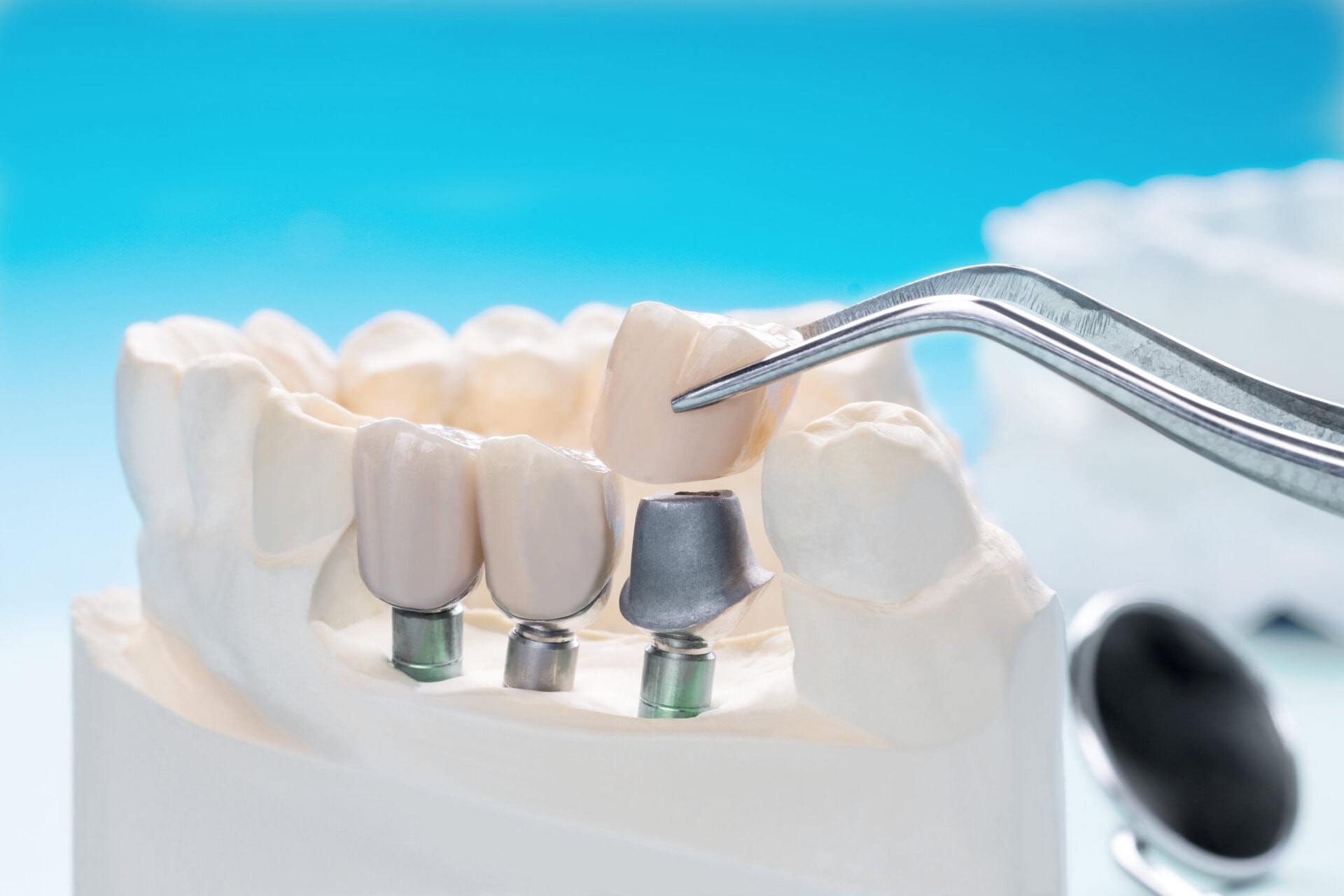
Porcelain dental veneers are categorized under 4 groups.
Porcelain Laminate: Some abrasion is made from the surface of the tooth and very thin sheets of porcelain are adhered to the tooth. It does not contain metal and is resistant to breakage.
Zirconium Veneer: Zirconium, a white metal present in nature, stands out with its durability and aesthetic appearance. Zirconium porcelain veneers can be used on front and back teeth.
Metal Supported Veneers: During the construction phase, metal is left under the porcelain. It provides the required durability in harmony with the tooth tissue. Since the metal in the substructure does not transmit light, a matte appearance may occur on the gums. It is generally preferred to be applied to the back teeth.
Full Porcelain Dental Veneers: It is a type of porcelain dental coating applied on the tooth. The perimeter of the tooth to be applied is prepared for coating by shaving equally. Its durability is increased by adding glass ceramic on the ceramic pieces. It may be preferred for crooked and broken teeth.
In the porcelain coating method, metal-supported coating is made to ensure durability. The metal bridge used in porcelain dental veneers using a material called dental ceramic is usually platinum or gold. If these metals are alloyed, it is possible to increase durability and reach the strength of steel. However, metals are not fully compatible with teeth and gums and do not have light transmittance. This can result in a dull and dull appearance, far from the natural tooth color.
In porcelain dental veneer treatment, the color of the metals is darkened to provide fixation to the tooth, and due to the placement of a dark substance under the tooth, a purple color forms around the gum over time. Gum recession may even occur.
If the porcelain dental veneer does not fully fit the gum, food residues accumulate in the gaps between the tooth and the veneer. Bad breath and tooth decay may occur. In such cases, porcelain dental veneers can turn into a disadvantage for patients who want to achieve an aesthetic appearance.
Porcelain dental veneers can cause an artificial appearance on the front teeth because they are not permeable to light. In porcelain dental veneer treatment, natural teeth are intervened with cutting, thinning and filing processes. A rough appearance can be prevented by removing excess tooth tissue.
In zirconium tooth coating treatment, tooth coating without metal support is applied. Zirconium, a light-permeable substance, provides a natural appearance. Zirconium coating does not damage teeth and gums. While zirconium dental coating, which provides easy adaptation, intervention to natural teeth is at a minimum level. It is no different from natural teeth in terms of hot - cold permeability and sensitivity. Although it is a thin and transparent substance, zirconium has an extremely robust structure.
For at least 1 week after porcelain dental veneers treatment, extremely hot - extremely cold foods and drinks and hard foods that can stick to the teeth should not be consumed. Proper oral hygiene is very important for the safe and healthy use of porcelain dental veneers for a long time. To ensure this, teeth should be brushed regularly with non-abrasive toothpastes. Dental floss should be used twice a day and care should be taken to use mouthwash after each tooth brushing.
Although the risk of staining of porcelain dental veneers is extremely low, consumption of acidic foods and beverages should be avoided to ensure long-lasting use. In addition, tea, coffee, cigarettes, cherry juice, caramel, tomato paste, red wine and other foods and beverages that may cause discoloration on the teeth should be avoided.
Avoiding impacts that may cause damage to porcelain dental veneers, being careful during the consumption of hard foods and not tearing the food with the front teeth can be listed among other factors to be considered. People who have porcelain dental veneers treatment should use protective aligners at night if they have the habit of clenching or grinding their teeth. In this way, it may be possible to use porcelain dental veneers safely for a long time.
Porcelain dental veneer prices are determined according to the scope of the treatment to be applied, how many teeth will be porcelain veneered, the quality of the material to be used, whether different dentistry procedures are needed, the price policy of the clinic and many other factors. In addition to these, how many sessions the application will be completed is one of the factors taken into consideration when determining porcelain dental veneer prices.
